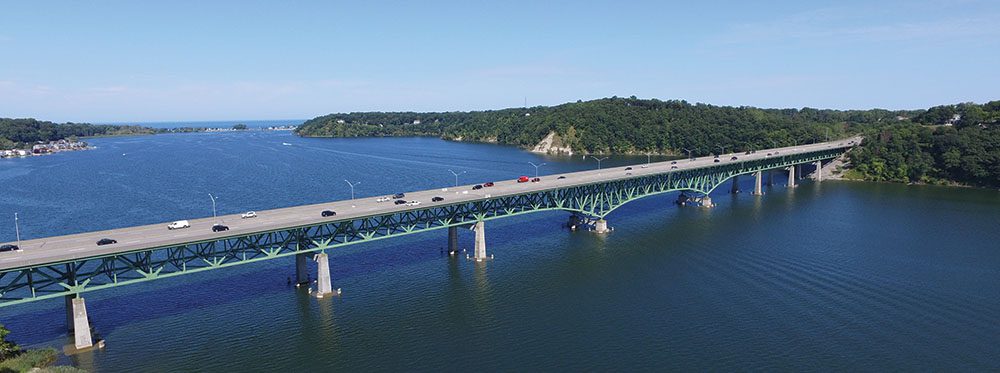The following is the third in a seven-part series. We hope you’ll enjoy.
A fierce controversy erupted in Monroe County during the winter of 1969, as construction of the long-awaited bridge over Irondequoit Bay inched toward its conclusion. What would the new bridge be called? The New York State Department of Transportation cautioned local officials that a bridge built in part with federal funds could not be named after any individual. This meant that bills to name the structure “Hiawatha Peace Bridge,” “Daniel Webster Highway,” or even “Bernard F. Perry Bridge,” after the state transportation department district engineer, died before they could come to a vote.
“There’s more discussion and fur-flying in the naming of this span than there was in the $90 million bond issue authorized for anti-pollution of Irondequoit Bay’s watershed,” observed Democrat & Chronicle columnist Bill Beeney. Another entry had surfaced: the late Major Donald W. Holleder, a Webster native who died in Vietnam while aiding other soldiers under active fire. “I don’t know why they don’t just call it the Maj. Donald W. Holleder-Bernard F. Perry-Hiawatha-Iroquois-Webster-Irondequoit Bay Bridge and be done with it,” Beeney concluded.
The planned 2,375-foot-long bridge would take some of the traffic pressure off of the Keeler Street Expressway (now NY Route 104). It would also provide a much-needed link in the 16-mile expressway system that stretched from Rochester to Wayne County. With a price tag that eventually topped $9.4 million ($64 million in 2020 dollars), the bridge had been a political hockey puck for more than three decades. In the interim, a new method of installing bridge foundations had been put into practical use for the Chesapeake Bay Bridge, allowing Irondequoit Bay construction crews to drive 168 pilings in 16 clusters into the sand and gravel on the bay floor to a depth of 180 to 200 feet, instead of 320 feet as originally designed. This cut the cost of the project significantly.
Construction began in 1967, and the bridge officially opened in the midst of a windblown, snow-covered day on February 3, 1970, as officials shivered in the frigid air just long enough to cut the ribbon.
“We couldn’t have had a worse day for it,” Perry quipped. Irondequoit Supervisor Julian S. Underhill poured a cup of red wine “right from my refrigerator” for Webster Supervisor Walter W. Bradley and other guests in lieu of champagne. By the time any of them got the cups to their lips, however, snow already crusted the wine’s surface. They snipped the ribbon and waiting snowplows rolled over the bridge, spreading an inaugural layer of salt.
The plows were not the first vehicles to cross the new expanse, however. The previous day, police officers drove across it at about 5 a.m. on a mission of mercy, transporting one-year-old Kevin Lohse from his Webster home to Rochester General Hospital. The baby suffered from a case of the flu and suddenly appeared to be suffocating. Police responded to Mrs. Lohse’s distress call and quickly determined that the bridge presented the fastest route to the hospital. Young Kevin arrived at the hospital in minutes and was soon out of danger.
As for the name of the bridge … the only avenue left open to the area’s legislators turned out to be the obvious one. The structure remains the Irondequoit Bay Bridge to this day, making it particularly easy to locate on a map—and it continues to bring more than 67,000 people across its expanse on a daily basis.
Read the next piece in this seven-part series: Webster Candy Kitchen: Sweets & Treats

